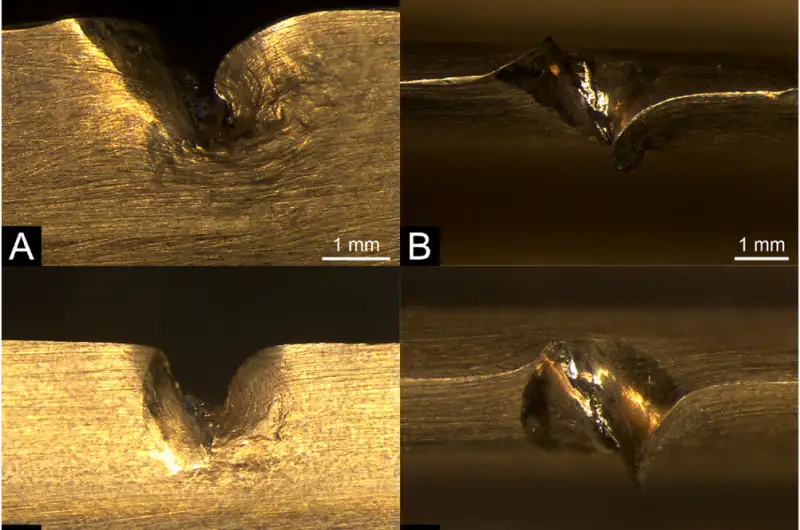Understanding how ancient weapons were used in combat provides a valuable window into the past, shedding light on the battle strategies, physical skills, and technologies of early civilizations. A new study by a research team from the University of Göttingen has developed a groundbreaking method to explore the use of prehistoric weapons, specifically Bronze Age spears. By simulating combat scenarios and analyzing the resulting wear on weapon replicas, the researchers have gained critical insights into fighting techniques, dexterity, and the evolution of ancient weaponry. Their findings were recently published in the Journal of Archaeological Science.
Simulating Ancient Combat: A Step-by-Step Approach
The team’s innovative approach involves reconstructing realistic Bronze Age combat scenarios using detailed spear replicas. These simulations allowed them to observe firsthand how the spears responded when they clashed with other materials like metal blades, wooden shields, and even animal tissues mimicking the human body. By repeating these experiments step by step, the researchers could track how marks on the weapons formed, changed, and accumulated over time, providing key insights into the dynamics of ancient spear fighting.
“We wanted to simulate the actual conditions under which these weapons were used, to understand how different materials interacted and how the spears would have performed in real combat,” explains Dr. Valerio Gentile, a researcher involved in the study.
Dr. Gentile, who conducted the study as part of his Ph.D. at the University of Leiden and continues similar research at Göttingen University, emphasized the significance of this method in advancing the understanding of ancient combat. “Our goal was to develop a repeatable method that could accurately replicate the marks found on archaeological spearheads. This allows us to interpret the wear patterns on ancient weapons with much greater precision.”
A New Way to Read Weapon Marks
One of the most significant outcomes of this research is the ability to identify and categorize impact marks on spears, which can then be used to interpret how these weapons were wielded in the past. Previous archaeological discoveries often included spearheads with damage or wear, but without a reliable method to link these marks to specific combat scenarios, their true significance remained elusive.
The team’s experiments with the spear replicas revealed the distinct types of marks created by collisions with different materials, offering a valuable comparative framework. The marks on the spears mirrored those found on many archaeological artifacts, meaning that researchers now have a new, scientifically-backed approach to reconstructing whether and how ancient weapons were used in actual combat.
Insights into Fighting Techniques and Skill
By analyzing the pattern and frequency of marks, the team could infer the kinds of fighting techniques employed by Bronze Age warriors. Their findings suggest that various levels of skill were involved, depending on the style of fighting—whether it was large-scale battle formations or more intimate one-on-one duels.
“Our research provides clues to the specific techniques used in spear fighting, as well as the physical dexterity needed to execute them,” says Dr. Gentile. “We now have a better understanding of how Bronze Age fighters used their weapons in battle and what strategies they might have employed.”
Impact on Future Archaeological Research
The implications of this study extend beyond the immediate analysis of combat. The team has created a guide for recognizing and interpreting the wear and tear on Bronze Age weapons, offering museum curators and archaeologists a powerful tool to revisit collections with a fresh perspective. This resource will enable them to compare marks on spearheads with those documented in the experiments, leading to more informed interpretations of ancient warfare.
“Our experiments will benefit future research because we have created a useful guide to recognize and understand the wear and tear on Bronze Age weapons,” notes Dr. Gentile. “This information source will allow researchers to study the objects already in their collections with a new lens. They can compare the marks they find with the ones we have documented and made freely available.”
Understanding the Nature of Bronze Age Conflicts
This new method may also provide insights into the broader context of Bronze Age conflicts. The wear patterns on weapons can indicate whether they were used in large-scale battles or more isolated combat encounters, such as duels. This distinction is crucial for historians seeking to understand the intensity, scale, and nature of conflicts in ancient societies.
“The ability to differentiate between weapons used in duels versus those in large-scale battles gives us a more nuanced picture of how conflicts were fought in the past,” Dr. Gentile explains. “It helps us to better grasp the social and political dynamics of the time, offering a clearer picture of how warriors were trained, how they fought, and how their societies were structured around combat.”
